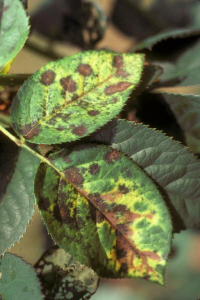Roses are a popular plant known for their large, elegant flowers. Many gardeners try their hands at growing roses in their gardens and landscapes. Poor disease control is one of the most common causes of failure with roses. Black spot and powdery mildew are important diseases to be aware of when growing roses.
Black spot is the most serious disease of roses in North Carolina. Black spot is a fungal disease that causes circular black spots with a frayed margin on the upper leaf surface. These black spots start small and will enlarge and increase in number. Eventually the infected leaf will turn yellow resulting in premature defoliation. If no action is taken to control the disease, defoliation will continue which will weaken the plant and reduce flower production. These weakened plants will become much more susceptible to other diseases and to winter injury. Black spot spreads from leaf to leaf during wet periods and new spots develop in 5 to 10 days.
Black spot has to be controlled in order to grow good roses. Black spot can not be adequately controlled without a good spray program. Do not let the disease build up before starting a spray program. A complete uniform spray on both sides of leaves is necessary. Spray applications must begin as new growth starts in the spring and continued at 7 to 10 day intervals and after heavy rains for the entire growing season. If the disease occurs, immediately remove infected leaves from the rose garden as they appear and rake up and/or discard old fallen leaves during the winter months. During the winter, remove all leaves from the plants and discard. In the fall prune hybrid tea roses to about 18 inches and destroy plant material. In the spring, prune again to about 10 to 18 inches and destroy plant material.
Powdery mildew is a very common fungus disease on roses. Powdery mildew is evident by the white mold that occurs of the surface of young leaves, shoots, and flower buds. The disease causes leaf distortion but less leaf drop than black spot causes. Powdery mildew is usually more severe in shady areas and during cool periods. The fungus is windborne and can increase during periods of heavy dew. The diseased foliage and canes should be removed and destroyed during the growing season along with following a fungicide spray program.
There are several fungicides that can provide excellent control of black spot and powdery mildew. A recommended spray program includes the use of chlorothalonil (Daconil) and alternating with one of the following three fungicides: triforine (Funginex), propiconazole (Banner Maxx), or myclonbutanil (Immunox, Eagle, or Systhane). Spray applications should be made every 7 to 10 days. Remember when spraying to completely cover all plant surfaces for best results. Read and follow all label directions when using fungicides.
Recommendations for the use of agricultural chemicals are included in this article as a convenience to the reader. The use of brand names and any mention or listing of commercial products or services in this article does not imply endorsement by North Carolina Cooperative Extension nor discrimination against similar products or services not mentioned. Individuals who use agricultural chemicals are responsible for ensuring that the intended use complies with current regulations and conforms to the product label. Be sure to obtain current information about usage regulations and examine a current product label before applying any chemical.
Jessica Strickland is an agriculture extension agent, specializing in horticulture for North Carolina Cooperative Extension in Wayne County.

(Photo credit: NC State Extension)

